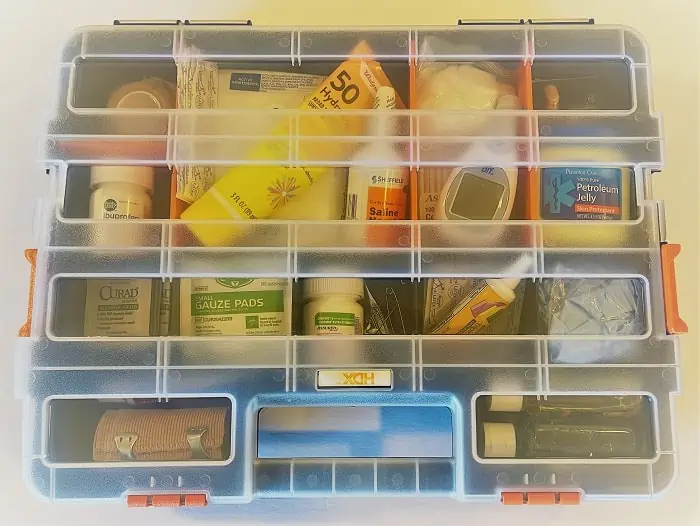Best DIY First Aid Kit For Your Car
It’s good to be prepared for emergencies when you are out on the road for longer than just your commute to work (and I know a commute can be long sometimes). A well-stocked first-aid kit is an excellent thing to have. There are many, many pre-packaged kits to buy out there. You can find them online and in stores. But it is easy to put together the best DIY First Aid Kit for your car.
Many people wonder, “Should you have a first aid kit in your car?” Last year, when I wrote about planning our cross-country from Anchorage, AK to Bend, OR, I briefly mentioned bringing a first aid kit. But nothing about what you should have inside the kit.
This article may contain affiliate links. We may earn a commission if you use these links to buy products or services. Please see our disclosure policy for full details. Thanks.
You Need A Box Or Case For Your DIY First Aid Kit
Use a container rather than a bag for your DIY first aid kit for your car. Bags can quickly get squished and lost inside your car. Any box with a lid that stays shut (to keep the supplies from falling out if it gets jostled) will work.
I am a little OCD and like organization. If you are like me, find a first-aid box with inner compartments to easily organize the items inside. I found this box at Home Depot. The two-box set only cost me $9.98, so $5.00 for the box! It is perfect for a first aid kit. You can easily re-arrange the interior compartments to meet your needs. Being organized this way means that in an emergency, you can get to the supplies quickly.


Your first aid kit doesn’t have to take up much space, but it should be stocked with everything you need to address an emergency, and it doesn’t have to be expensive. Almost everything in the picture below was purchased at the dollar store. Including the cost of the box, the total cost for my first-aid kit came to around $20.00.

Also, you don’t have to go out and buy everything new. You probably already have most of these items in larger quantities in your house. You should keep medicines with expiration dates and use instructions in their original containers. But otherwise, repackage items from home in smaller containers or even self-closing plastic bags. This is what I have done with some of the things in the picture.
Here Are Some Essential First Aid Kit Items
Below is a list of some essential items you should always keep in a well-stocked DIY first aid kit for your car. These items are based on the recommendations from the American Red Cross. Please remember to customize your kit. For example, if someone in your family is allergic to bee stings or peanuts, an epi-pen is a wise addition to the kit. Are you headed to someplace that has a lot of flying bugs like mosquitoes? You may want to add bug repellant.

- Antiseptic Wash, Hand sanitizer, or Wipes (like Purell & Germ-X)
- Saline solution for eye washing or cleaning wounds
- Disposal Gloves (try to stay away from latex as some people are allergic)
- Antiseptic (like Campho-Phenique) or Antibiotic (like Neosporin or Betadine)
- Hydrocortisone cream to stop the itching of insect bites, poison oak/ivy, etc.
- Antihistamine for allergic reactions
- Aspirin, Ibuprofen, or acetominiphen
- Aloe Vera to treat mild burns
- Adhesive Band-Aids for covering cuts
- Gauze pads for treating wounds
- Skin tape to secure the gauze – Nicer to skin than adhesive tape
- An Elastic Bandage (ACE Bandage) for minor sprains
- Safety pins for closing bandages
- Sunscreen
- Cotton balls / swabs
- Vaseline
- Tweezers (to remove the inevitable splinters)
- A digital thermometer
Many of these items are either-or choices. You probably don’t need both ibuprofen and acetaminophen; or an Antiseptic and Antibiotic. You can choose the things that work best for you. Now you have your own customized DIY first-aid kit for your car.
A Couple Of Quick Reminders
1. When you use an item from the kit, you need to replace it as soon as you get home. This way, your kit will always be fully stocked.
2. Review each item in the kit for expiration dates at least twice a year and replace it as needed.
Think You Might Want Some Training In First Aid?
The American Red Cross offers classes from beginning to advance first aid training all over the US. Head over to their website and choose your location and the type of training you are looking for. Having all the supplies is one thing. Knowing how to use them in an emergency is another.
Know When To Seek Help
I am not a medical professional. But I do know that even the best DIY first-aid kit is only intended to help manage a non-emergency injury or medical issue. A scraped knee, hay fever, or a minor headache are things we all deal with daily.
For severe problems, such as a large wound that won’t stop bleeding or a blow to the head, call for help or head directly to the nearest emergency room. No road trip or vacation is worth sacrificing your health or the health of your family.







